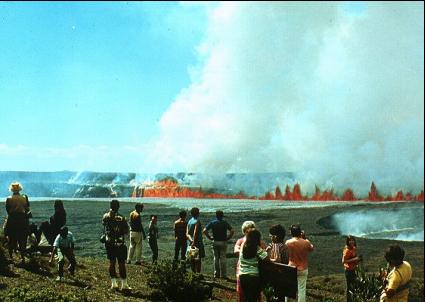Ash started spewing continuously from Halemaumau Crater Monday following a small eruption Sunday evening, the Hawaiian Volcano Observatory reported Monday afternoon.
"It is significant," Park Ranger Mardie Lane said. "It's a huge ash plume."
The ash is flowing from a new gas vent in the crater, and turned the fume cloud, which previously was white, to a "dusty-brown color," Scientist-in-Charge Jim Kauahikaua said in a prepared statement. Sunday evening, incandescent particles were seen erupting from the vent below the Halemaumau Overlook; some of the particles were ejected with enough force to be deposited on the rim of the crater, HVO said. Geologists found Pele's hair, Pele's tears and spatter in the overlook area, signs of the first molten lava to erupt from the vent, which is now about 100 feet wide. It is also the first lava to erupt anywhere in Halemaumau since 1982. The largest fragments of spatter were about 4 inches.
The exact significance of the ash plume and changes in emissions levels is something scientists are studying, Mayor Harry Kim said.
"I asked that question, too," said Kim, who is also the acting Hawaii County Civil Defense administrator. "The
answer so far is, we don't know. This is the first time Halemaumau has emitted this amount of sulfur dioxide. The scientists are trying to make an assessment of what's happening."
Kim said a variety of county, state and federal agencies are working together to collect data from the new vent, to determine which warnings need to be issued to county residents. He reminded residents to be watchful of the vog, adding that sulfur dioxide levels could be elevated from normal without the telltale vog cloud, however.
An air space safety warning was issued for private and commercial aircraft, alerting pilots to the possibly safety hazards because of the emissions, Kim said.
Members of the Hawaii National Guard's 93rd Civil Support unit were at the park Monday, helping county agencies measure sulfur dioxide emissions levels at the vent, as well as in other areas affected, Lt. Col. Trey Johnson said.
The team is conducting "hazard and risk assessments, identifying debris, and the location of sulfur dioxide emitting from the lava flow," Johnson said. "It's designed to get some tangible readings in accurate, real time."
The data will be put into a program that, based upon current weather conditions, can show where the plume will drift. Members of the unit also hope to install five permanent monitors near the vent, to help to continue to track emissions, Johnson said.
For more information on seeing the lava or touring Hawaii VOlcanoes National Park, visit www.tourguidehawaii.com.
Subscribe to:
Post Comments (Atom)


No comments:
Post a Comment